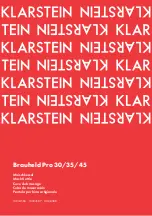
IM6016
REDI-MIG
®
Plus 215C, 255C, 255S
Page 19
3. The Correct Electrical Stickout (ESO)
The electrical stickout (ESO) is the distance from the
end of the contact tip to the end of the wire. See Figure
9.
Once the arc has been established, maintaining the
correct ESO becomes extremely important. The ESO
should be approximately 10 to 12 mm long.
The easiest way to tell whether the ESO is the correct
length is by listening to its sound. The correct ESO has
a distinctive “crackling” sound, very much like eggs
frying in a pan. A long ESO has a hollow, blowing or
hissing sound. If the ESO is too short, you may stick the
contact tip or nozzle to the weld puddle and/or fuse the
wire to the contact tip.
4. The Correct Welding Speed
The important thing to watch while welding is the puddle
of molten metal right behind the arc. See Figure 10.
Do not watch the arc itself. It is the appearance of the
puddle and the ridge where the molten puddle solidifies
that indicates correct welding speed. The ridge should
be approximately 10 mm behind the wire electrode.
Most beginners tend to weld too fast, resulting in a thin,
uneven, “wormy” looking bead. They are not watching
the molten metal.
Helpful Hints
1. For general welding, it is not necessary to weave the
arc, neither forward or backward nor sideways. Weld
along at a steady pace. You will find it easier.
2. When welding on thin plate, you will find that you will
have to increase the welding speed, whereas when
welding on heavy plate, it is necessary to go more
slowly in order to get good penetration.
3. When welding sheet metal 1.6mm and lighter, heat
buildup may cause part warpage and burn through.
One way to eliminate these problems is to use the
back-stepping method illustrated in Figure 6.
Practice
The best way of getting practice in the four skills that
enable you to maintain:
1. Correct welding position
2. Correct way to strike an arc
3. Correct electrical stickout
4. Correct welding speed
is to perform the following exercise.
Refer to Figure 4.
Refer to Figure 7.
1. Learn to strike an arc by positioning the gun over the
joint and touching the wire to the work.
2. Position face shield to protect face and eyes.
3. Depress gun trigger, hold gun so contact tip to work
distance Is about 10-12 mm and the gun is at proper
angle.
4.
After you strike the arc, practice the correct electrical
stickout. Learn to distinguish it by its sound.
5.
When you are sure that you can hold the correct electrical
stickout, with a smooth “crackling” arc, start moving. Look
at the molten puddle constantly,
6.
Run beads on a flat plate. Run them parallel to the top
edge (the edge farthest away from you). This gives you
practice in running straight welds, and also gives you
an easy way to check your progress. The 10th weld will
look considerably better than the first weld. By constantly
checking on your mistakes and your progress, welding will
soon be a matter of routine.
5.10 Joint Types and Positions
Five types of welding joints are: Butt Welds, Fillet Welds,
Lap Welds, Edge Welds and Corner Welds. See Figure 10.
Of these, the Butt Weld and Fillet Weld are the two most
common welds.
5.11 Butt Welds
Place two plates side by side, leaving a space approximately
one half the thickness of the metal between them in order
to get deeper penetration.
Securely clamp or tack weld the plates at both ends,
otherwise the heat will cause the plates to move apart. See
Figure 11.
Now weld the two plates together. Weld from left to right
(if right handed and using self-shielded FCAW process).
Point the wire electrode down in the crack between the two
plates, keeping the gun slightly tilted in the direction of travel.
Watch the molten metal to be sure it distributes itself evenly
on both edges and in between the plates.
5.12 Penetration
Unless a butt weld penetrates close to 100% of the metal
thickness, a butt weld will be weaker than the material
welded together. In the example shown in Figure 12, the
total weld is only half the thickness of the material thus the
weld is only approximately half as strong as the metal.
In the example shown in Figure 13, the joint has been
welded so that 100% penetration could be achieved. The
weld, if properly made, is as strong as or stronger than the
original metal.
Figure 10
Mild Steel Sheet
(1.6 mm)
Wire size and type
0.9mm Ultramag S6
Argon/CO
2
Blend
Voltage Setting
4
Wire Feed Speed
3
For the REDI-MIG
®
Plus 255C, use the following:
Butt weld
Lap weld
Edge weld
Fillet weld
Corner weld
Figure 10
Figure 12
Figure 11








































